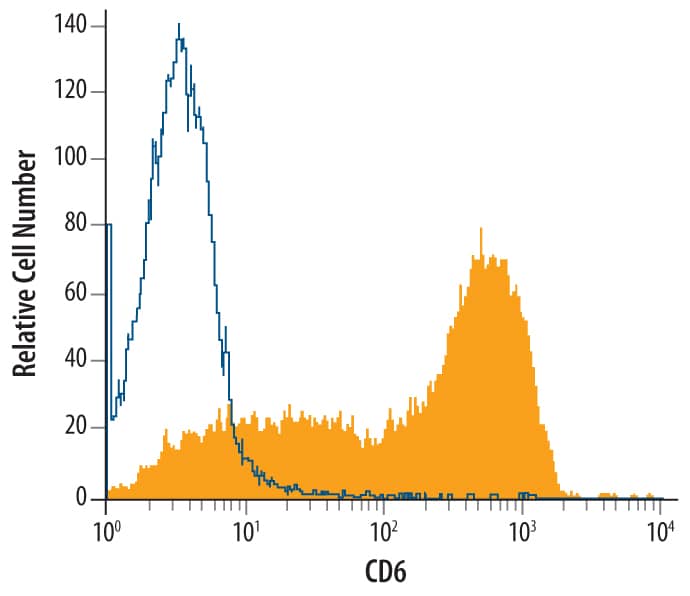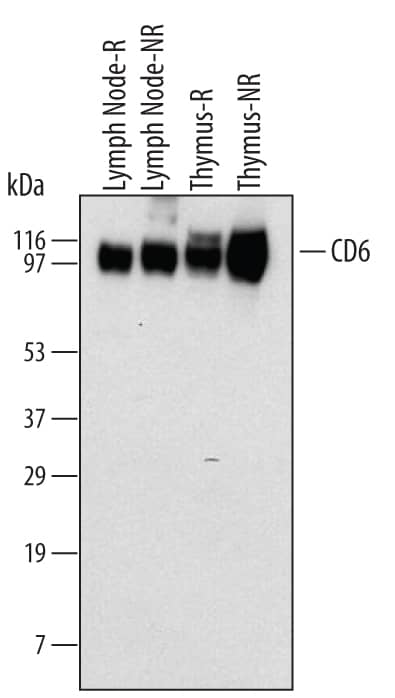Recombinant Human CD6 Fc Chimera Protein, CF Summary
Product Specifications
| Human CD6 (His18-Glu398) Accession # AAA86417.1 |
DIEGRMD | Human IgG1 (Pro100-Lys330) |
6-His tag |
| N-terminus | C-terminus | ||
Analysis
Customers also Viewed
Product Datasheets
Carrier Free
CF stands for Carrier Free (CF). We typically add Bovine Serum Albumin (BSA) as a carrier protein to our recombinant proteins. Adding a carrier protein enhances protein stability, increases shelf-life, and allows the recombinant protein to be stored at a more dilute concentration. The carrier free version does not contain BSA.
In general, we advise purchasing the recombinant protein with BSA for use in cell or tissue culture, or as an ELISA standard. In contrast, the carrier free protein is recommended for applications, in which the presence of BSA could interfere.
627-CD
| Formulation | Lyophilized from a 0.2 μm filtered solution in PBS. |
| Reconstitution | Reconstitute at 100 μg/mL in sterile PBS. |
| Shipping | The product is shipped at ambient temperature. Upon receipt, store it immediately at the temperature recommended below. |
| Stability & Storage: | Use a manual defrost freezer and avoid repeated freeze-thaw cycles.
|
Background: CD6
CD6 is a member of the group B scavenger receptor cysteine-rich (SRCR) superfamily. CD6 is a type I membrane glycoprotein and contains three extracellular SRCR domains. CD6 is expressed at low levels on immature thymocytes and at high levels on mature thymocytes. The majority of peripheral blood T cells, a subset of B cells, and a subset of neuronal cells express CD6. CD6 is a 668 amino acid protein with a 24 amino acid predicted signal sequence, a 374 amino acid extracellular domain, and a 244 amino acid transmembrane region. The 626 amino acid murine homolog has also been identified. The human and murine proteins share 70% amino acid identity over their full-lengths.
The role of CD6 has not been fully elucidated. However, it appears to play a role as both a co-stimulatory molecule in T cell activation and as an adhesion receptor. Studies demonstrating a mitogenic effect for T cells with some CD6 specific monoclonal antibodies, in conjunction with either accessory cells or PMA and anti-CD2 mAb, support the concept of CD6 as a co-stimulatory molecule. Anti-CD6 monoclonal antibody has been used as an immunosuppressive agent for patients undergoing kidney or bone marrow allograft rejection. It has also been used to remove CD6+ T cells from donor bone marrow prior to allogeneic bone marrow transplantation. Other studies have demonstrated an adhesive role for CD6, it has been demonstrated to bind the activated leukocyte cell adhesion molecule (ALCAM, CD166). CD6/ALCAM interactions have been postulated to play a role in thymocyte development. The presence of ALCAM on neuronal cells may provide a mechanism of interaction between CD6+ T cells and ALCAM+ neuronal cells. Phosphorylation of the CD6 molecule appears to play a role in CD6-mediated signal transduction. Serine and threonine residues become hyperphosphorylated and tyrosine residues become phosphorylated when T cells are activated with anti-CD6 mAb in conjunction with PMA, anti-CD2, or anti-CD3 mAb. The CD6 intracellular domain contains regions that can interact with SH2 or SH3 containing proteins. However, the signaling pathways have not been elucidated.
- Gangemi, R.M. et al. (1989) J. Immunol. 143:2439.
- Aruffo, A. et al. (1991) J. Exp. Med. 174:949.
- Swack, J.A. et al. (1991) J. Biol. Chem. 266:7137.
- Robinson, W.H. et al. (1995) Eur. J. Immunol. 25:2765.
- Whitney, G. et al. (1995) Mol. Immunol. 32:89.
- Starling, G.C. et al. (1996) Eur. J. Immunol. 26:738.
- Degen, W.G. et al. (1998) Am. J. Pathol. 152:805.
- Swack, J.A. et al. (1989) Mol. Immunol. 26:1037.
- Pawelec, G. and H.J. Buhring (1991) Hum. Immunol. 31:165.
- Osorio, L.M. et al. (1995) Cell Immunol. 166:44.
- Robinson, W.H. et al. (1995) J. Immunol. 155:4739.
- Singer, N.G. et al. (1996) Immunology 88:537.
- Aruffo, A. et al. (1997) Immunol. Today 18:498.
Citations for Recombinant Human CD6 Fc Chimera Protein, CF
R&D Systems personnel manually curate a database that contains references using R&D Systems products. The data collected includes not only links to publications in PubMed, but also provides information about sample types, species, and experimental conditions.
8
Citations: Showing 1 - 8
Filter your results:
Filter by:
-
CDCP1 regulates retinal pigmented epithelial barrier integrity for the development of experimental autoimmune uveitis
Authors: L Zhang, N Borjini, Y Lun, S Parab, G Enyindah-A, R Singh, BA Bell, VL Bonilha, AI Ivanov, DA Fox, RR Caspi, F Lin
JCI Insight, 2022-09-22;0(0):.
Species: Human
Sample Types: Whole Cells
Applications: Cell Culture -
CD318 is a ligand for CD6
Authors: G Enyindah-A, Y Li, JH Ruth, DS Spassov, KE Hebron, A Zijlstra, MM Moasser, B Wang, NG Singer, H Cui, RA Ohara, SM Rasmussen, DA Fox, F Lin
Proc. Natl. Acad. Sci. U.S.A., 2017-07-31;0(0):.
Species: Human
Sample Types: Whole Cells
Applications: Bioassay -
Dynamic coupling of ALCAM to the actin cortex strengthens cell adhesion to CD6.
Authors: Te Riet J, Helenius J, Strohmeyer N, Cambi A, Figdor C, Muller D
J Cell Sci, 2014-02-04;127(0):1595-606.
Species: Human
Sample Types: Whole Cells
Applications: Bioassay -
Cytomegalovirus impairs cytotrophoblast-induced lymphangiogenesis and vascular remodeling in an in vivo human placentation model.
Authors: Tabata T, Petitt M, Fang-Hoover J, Rivera J, Nozawa N, Shiboski S, Inoue N, Pereira L
Am J Pathol, 2012-09-07;181(5):1540-59.
Species: Human
Sample Types: Whole Cells
Applications: Bioassay -
Cytotrophoblast induction of arterial apoptosis and lymphangiogenesis in an in vivo model of human placentation.
Authors: Red-Horse K, Rivera J, Schanz A, Zhou Y, Winn V, Kapidzic M, Maltepe E, Okazaki K, Kochman R, Vo KC, Giudice L, Erlebacher A, McCune JM, Stoddart CA, Fisher SJ
J. Clin. Invest., 2006-09-21;116(10):2643-52.
Species: Human
Sample Types: Whole Cells
Applications: Bioassay -
Mast cell CD30 ligand is upregulated in cutaneous inflammation and mediates degranulation-independent chemokine secretion.
Authors: Fischer M, Harvima IT, Carvalho RF, Moller C, Naukkarinen A, Enblad G, Nilsson G
J. Clin. Invest., 2006-09-07;116(10):2748-56.
Species: Human
Sample Types: Whole Cells
Applications: Bioassay -
Mitogen-activated protein kinase pathway activation by the CD6 lymphocyte surface receptor.
Authors: Ibáñez A, Sarrias MR, Farnos M, Gimferrer I, Serra-Pages C, Vives J, Lozano F
J. Immunol., 2006-07-15;177(2):1152-9.
Species: Human
Sample Types: Whole Cells
Applications: Bioassay -
Long-term engagement of CD6 and ALCAM is essential for T-cell proliferation induced by dendritic cells.
Authors: Zimmerman AW, Joosten B, Torensma R, Parnes JR, van Leeuwen FN, Figdor CG
Blood, 2005-12-13;107(8):3212-20.
Species: Human
Sample Types: Whole Cells
Applications: Bioassay
FAQs
No product specific FAQs exist for this product, however you may
View all Proteins and Enzyme FAQsReviews for Recombinant Human CD6 Fc Chimera Protein, CF
There are currently no reviews for this product. Be the first to review Recombinant Human CD6 Fc Chimera Protein, CF and earn rewards!
Have you used Recombinant Human CD6 Fc Chimera Protein, CF?
Submit a review and receive an Amazon gift card.
$25/€18/£15/$25CAN/¥75 Yuan/¥2500 Yen for a review with an image
$10/€7/£6/$10 CAD/¥70 Yuan/¥1110 Yen for a review without an image













